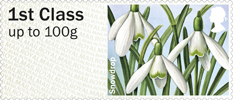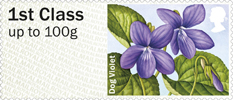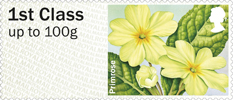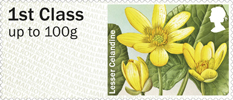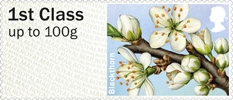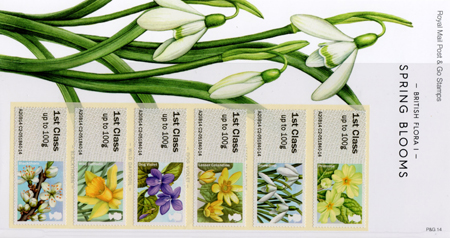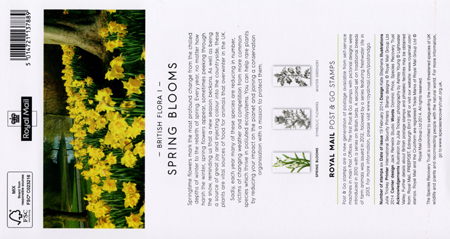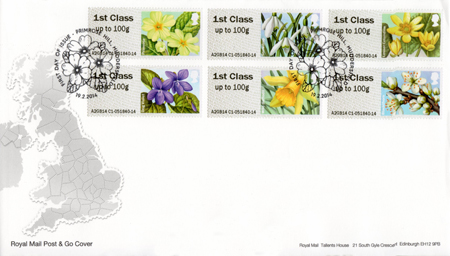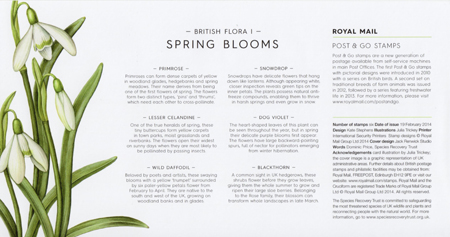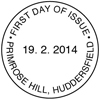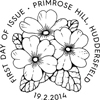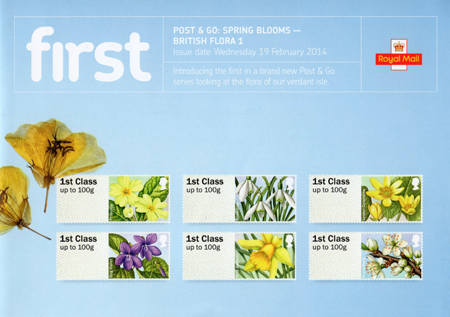Post & Go: Spring Blooms - British Flora 1
Springtime flowers mark the most profound change from the chilled depths ofwinter to the rebirth of spring. Every year, no matter how harsh the winter, spring
flowers appear, sometimes peeking through the snow, reminding us that a new
season beckons. As well as being a source of great joy and injecting colour into the
countryside, these plants are vital sources of food for animals that hibernate over
winter in the UK.
2014 (February 19 2014)
Designed by Kate Stephens
Size 56mm (h) x 25mm (v)
Printed by Walsall Security Printers
Print Process Gravure
Stamps
Snowdrop
1stImage preview by Royal Mail
Snowdrop (Galanthus nivalis) can flower from January: Snowdrops have delicate flowers that hang down like lanterns. Although appearing white, closer inspection reveals green tips on the inner petals. The plants possess natural antifreeze compounds, enabling them to thrive in harsh springs and even grow in snow.
Dog Violet
1stImage preview by Royal Mail
Dog Violet (Viola riviniana): The heart-shaped leaves of this plant can be seen throughout the year but in spring their delicate purple blooms first appear. The flowers have large backward-pointing spurs, full of nectar for pollinators emerging from winter hibernation.
Wild Daffodil
1stImage preview by Royal Mail
Wild daffodil (Narcissus pseudonarcissus): An emblem of Wales and beloved by poets and artists, these swaying blooms with a yellow ‘trumpet’ surrounded by six paler-yellow petals flower from February to April. They are native to the south and west of the UK, growing on woodland banks and in glades.
Primrose
1stImage preview by Royal Mail
Primrose (Primula vulgaris): Primroses can form dense carpets of yellow in woodland glades, hedgebanks and spring meadows. Their name derives from being one of the first flowers of spring. The flowers form two distinct types, ‘pins’ and ‘thrums’, which need each other to cross-pollinate.
Lesser Celandine
1stImage preview by Royal Mail
Lesser Celandine (Ranunculus ficaria): Wordsworth’s favourite flower, called ‘spring messenger’ that reputedly always flowers on 21 Feb. One of the true heralds of spring, these tiny buttercups form yellow carpets in town parks, moist grasslands and riverbanks. The flowers open their widest on sunny days when they are most likely to be pollinated by passing insects.
Blackthorn
1stImage preview by Royal Mail
Blackthorn (Prunus spinosa): A white flowering plant, the Blackthorn is a common sight in UK hedgerows. These shrubs flower before they grow leaves, giving them the whole summer to grow and ripen their large sloe berries. Belonging to the Rose family, their blossom can transform whole landscapes in late March.

